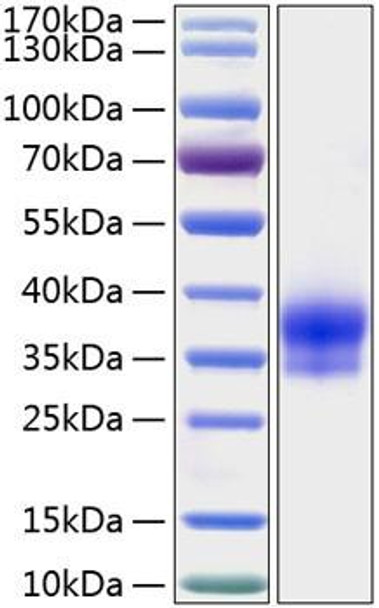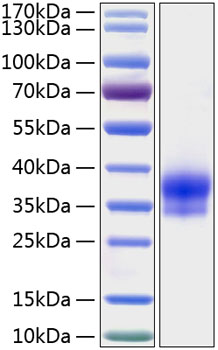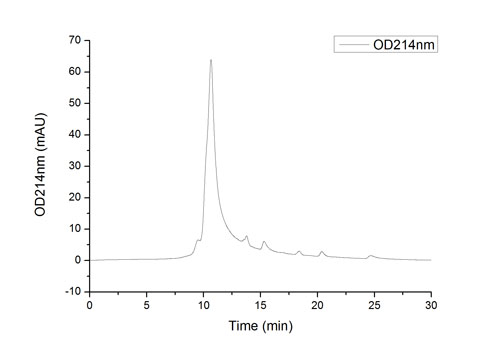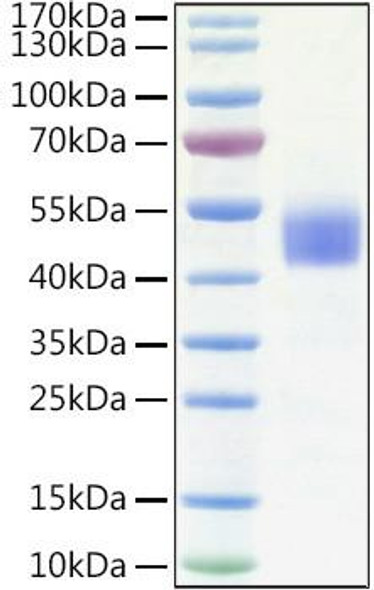Description
Recombinant Human IGFBP-6 Protein
The Recombinant Human IGFBP-6 Protein is a biologically active recombinant protein that plays a significant role in various cellular processes and signaling pathways in human biology. This protein is widely employed in immunological research, cell biology studies, protein-protein interaction analyses, and therapeutic development, providing researchers with a reliable tool for investigating IGFBP-6 function and its implications in health and disease.
This product (SKU: RPCB0296) is produced using HEK293 cells and features a C-His tag for convenient detection and purification. The protein exhibits a calculated molecular weight of 26.16 kDa with an observed molecular weight of 35-40 kDa under denaturing conditions, achieving ≥ 95 % as determined by SDS-PAGE;≥95 % as determined by HPLC.. Functional bioactivity has been validated through rigorous quality control assays, confirming its suitability for demanding research applications.
Key Features
| High Purity by Affinity Chromatography | |
| Mammalian & Bacterial Expression Systems | |
| High lot-to-lot consistency via strict QC |
| Product Name: | Recombinant Human IGFBP-6 Protein |
| SKU: | RPCB0296 |
| Size: | 10 μg , 20 μg , 50 μg , 100 μg |
| Reactivity: | Human |
| Synonyms: | IGFBP6, IBP6 |
| Tag: | C-His |
| Expression Host: | HEK293 cells |
| Calculated MW: | 26.16 kDa |
| Observed MW: | 35-40 kDa |
| Gene ID: | 3489 |
| Protein Description: | High quality, high purity and low endotoxin recombinant Recombinant Human IGFBP-6 Protein (RPCB0296), tested reactivity in HEK293 cells and has been validated in SDS-PAGE.100% guaranteed. |
| Endotoxin: | < 0.1 EU/μg of the protein by LAL method. |
| Purity: | ≥ 95 % as determined by SDS-PAGE;≥95 % as determined by HPLC. |
| Formulation: | Lyophilized from a 0.22 μm filtered solution of PBS, pH 7.4.Contact us for customized product form or formulation. |
| Bio-Activity: | Measured by its binding ability in a functional ELISA. Immobilized recombinant human IGFBP6 at 1 μg/mL (100 μL/well) can bind recombinant human IGF1 with a linear range of 30-250 ng/mL. |
| Reconstitution: | Centrifuge the vial before opening. Reconstitute to a concentration of 0.1-0.5 mg/mL in sterile distilled water. Avoid vortex or vigorously pipetting the protein. For long term storage, it is recommended to add a carrier protein or stablizer (e.g. 0.1% BSA, 5% HSA, 10% FBS or 5% Trehalose), and aliquot the reconstituted protein solution to minimize free-thaw cycles. |
| Storage: | Store at -20℃.Store the lyophilized protein at -20℃ to -80 ℃ up to 1 year from the date of receipt. After reconstitution, the protein solution is stable at -20℃ for 3 months, at 2-8℃ for up to 1 week. |
The superfamily of insulin-like growth factor (IGF) binding proteins include the six high-affinity IGF binding proteins (IGFBP) and at least four additional low-affinity binding proteins referred to as IGFBP related proteins (IGFBP-rP). All IGFBP superfamily members are cysteine-rich proteins with conserved cysteine residues, they can bind IGF-I and IGF-II with the equal affinity. Insulin-like growth factor (IGF) binding proteins (IGFBPs) have been shown to either inhibit or enhance the action of IGF, or act in an IGF-independent manner in the prostate. IGF-binding protein-4 (IGFBP-4) inhibits IGF-I action in vitro and is the most abundant IGFBP in the rodent arterial wall. IGFBP6 is directly downregulated by the beta-catenin/TCF complex in desmoid tumors, and imply a role for the IGF axis in the proliferation of desmoid tumors. There is mounting evidence that the structure of the IGFBP proteins plays a key role in the regulation of IGF bioavailability, by modulating its molecular size, capillary membrane permeability, target tissue specificity, cell membrane adherence and IGF affinity.








